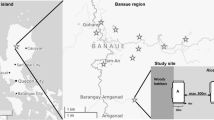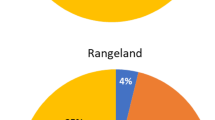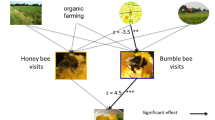Abstract
Pollinators face many challenges within agricultural systems due to landscape changes and intensification which can affect resource availability that can impact pollination services. This paper examines pigeon pea pollination and considers how landscape context and agricultural intensification in terms of pesticide use affects the abundance of bees characterized by species guilds on crops. The study was conducted on six paired farms across a gradient of habitat complexity based on the distance of each farm from adjacent semi-natural vegetation in Kibwezi Sub-county, Kenya. The study found that farms which do not use insecticides in farm management, but are in close proximity to natural habitat have greater bee guild abundance, but at further distances, overall abundance is reduced with or without insecticide use. At 1 km landscape radius, the complexity of habitats but not patch size had a positive impact on the abundance of cavity nesting bees and mason bees, which can be attributed to the interspersion of the small-holder farms with semi-natural habitats across the landscapes producing mosaics of heterogeneous habitats. The study revealed the strongest relationships between fruit set and bee abundance to be with the carpenter bee, social bee and solitary bee guilds, which are among the most abundant bees visiting pigeon pea flowers in this system. Our findings provide the foundation for conservation efforts by identifying which bee guilds pollinated pigeon peas. From this study, we suggest managing the floral and nesting resources that would best support the most abundant crop pollinators, and also reducing insecticide application to the crop.


Similar content being viewed by others
References
Allsopp M, Tirado R, Johnston P, Santillo D, Lemmens P (2014) Plan bee—living without pesticides moving towards ecological farming. Greenpeace International, Amsterdam, pp 21–39
Andersson GKS, Birkhofer K, Rundlof M, Smith HG (2013) Landscape heterogeneity and farming practice alter the species composition and taxonomic breadth of pollinator communities. Basic Appl Ecol 14:540–546
Archer CR, Pirk CWW, Carvalheiro LG, Nicolson SW (2014) Economic and ecological implications of geographic bias in pollinator ecology in the light of pollinator declines. Oikos 123(4):401–407
Bailey S, Requier F, Nusillard B, Roberts SPM, Potts SG, Bouget C (2014) Distance from forest edge affects bee pollinators in oilseed rape fields. Ecol Evol 4(4):370–380
Barbaro L, Pontcharraud L, Vetillard F, Guyon D, Jactel H (2005) Comparative responses of bird, carabid, and spider assemblages to stand and landscape diversity in maritime pine plantation forests. Ecoscience 12:110–121
Bates DM (2010) Lme4: mixed-effects modeling with R. Springer, Berlin
Blaum N, Mosner E, Schwager M, Jeltsch F (2011) How functional is functional? Ecological groupings in terrestrial animal ecology: towards an animal functional type approach. Biodivers Conserv 20:2333–2345
Blitzer EJ, Dormann CF, Holzschuh A et al (2012) Spillover of functionally important organisms between managed and natural habitats. Agric Ecosyst Environ 146:34–43
Bommarco R, Biesmeijer JC, Meyer B, Potts SG, Poyry J, Roberts SPM, Steffan-Dewenter I, Ockinger E (2010) Dispersal capacity and diet breadth modify the response of wild bees to habitat loss. Proc R Soc B 277:2075–2082
Brittain C, Potts SG (2011) The potential impacts of insecticides on the life-history traits of bees and the consequences for pollination. Basic Appl Ecol 12(4):321–331
Brittain CA, Vighi M, Bommarco R, Settele J, Potts SG (2010a) Impacts of a pesticide on pollinator species richness at different spatial scales. Basic Appl Ecol 11:106–115
Brittain C, Bommarco R, Vighi M, Barmaz S, Settele J, Potts SG (2010b) The impact of an insecticide on insect flower visitation and pollination in an agricultural landscape. Agric For Entomol 12:259–266
Cameron SA, Lozier JD, Strange JP, Koch JB, Cordes N, Solter LF, Griswold TL (2011) Patterns of widespread decline in North American bumble bees. PNAS 108:662–667
Carvalheiro LG, Seymour CL, Veldtman R, Nicolson SW (2010) Pollination services decline with distance from natural habitat even in biodiversity-rich areas. J Appl Ecol 47:810–820
Chateil C, Porcher E (2014) Landscape features are a better correlate of wild plant pollination than agricultural practices in an intensive cropping system. Agric Ecosyt Environ 201:51–57
Choudhary AK (2011) Effects of pollination control in pigeonpea and their implication. J Food Legumes 24(1):50–53
Coulson RN, Pinto MA, Tchakerian MD, Baum KA, Rubink WL, Johnston JS (2005) Feral honey bees in pine forest landscapes of east Texas. For Ecol Manag 215:91–102
Crawley MJ (2012) The R book. Wiley, London
de Bello F, Lavorel S, Díaz S, Harrington R, Cornelissen JHC, Bardgett RD, Berg MP, Cipriotti P, Feld CK, Hering D, Martins da Silva P, Potts SG, Sandin L, Sousa JP, Storkey J, Wardle DA, Harrison PA (2010) Towards an assessment of multiple ecosystem processes and services via functional traits. Biodivers Conserv 19:2873–2893
Deguines N, Jono C, Baude M, Henry M, Julliard R, Fontaine C (2014) Large-scale trade-off between agricultural intensification and crop pollination services. Front Ecol Environ 12:212–217
Elkie PC, Rempel RS, Carr AP (1999) Patch analyst user’s manual: a tool for quantifiying landscape structure. Ontario Ministry of Natural Resources. Northwest Science and Technology, Thunder Bay, Ont
Feltham H, Park K, Goulson D (2014) Field realistic doses of pesticide imidacloprid reduce bumblebee pollen foraging efficiency. Ecotoxicology 23:317–323
Ferreira PA, Boscolo D, Viana BF (2013) What do we know about the effects of landscape changes on plant–pollinator interaction networks? Ecol Indic 31:1–6
Garibaldi LA, Steffan-Dewenter I, Kremen C, Morales JM, Bommarco R, Cunningham SA, Carvalheiro LG, Chacoff NP, Dudenhoffer JH, Greenleaf SS, Holzschuh A, Isaacs R, Krewenka K, Mandelik Y, Mayfield MM, Morandin LA, Potts SG, Ricketts TH, Szentgyorgyi H, Viana BF, Westphal C, Winfree R, Klein AM (2011) Stability of pollination services decreases with isolation from natural areas despite honey bee visits. Ecol Lett 14:1062–1072
Garibaldi LA et al (2013) Wild pollinators enhance fruit set of crops regardless of honey bee abundance. Science 339:1608–1611
Hagen M, Kraemer M (2010) Agricultural surroundings support flower–visitor networks in an Afrotropical rain forest. Biol Conserv 143:1654–1663
Harrison S, Bruna E (1999) Habitat fragmentation and large-scale conservation: what do we know for sure? Ecol Indic 22:225–232
Hendrickx F, Maelfait JP, van Wingerden W, Schweiger O, Speelmans M, Aviron S, Augenstein I, Billeter R, Bailey D, Bukacek R, Burel F, Diekötter T, Dirksen J, Herzog F, Liira J, Roubalova M, Vandomme V, Bugter R (2007) How landscape structure, land-use intensity and habitat diversity affect components of total arthropod diversity in agricultural landscapes. J Appl Ecol 44:340–351
Holzschuh A, Steffan-Dewenter I, Tscharntke T (2008) Agricultural landscapes with organic crops support higher pollinator diversity. Oikos 117:354–361
Isaacs R, Kirk AK (2010) Pollination services provided to small and large highbush blueberry fields by wild and managed bees. J Appl Ecol 47:841–849
Jha S, Kremen C (2013) Resource diversity and landscape-level homogeneity drive natural bee foraging. Proc Natl Acad Sci USA 110:555–558
Karanja RHN, Njoroge G, Gikungu M et al (2010) Bee interactions with wild flora around organic and conventional coffee farms in Kiambu Sub-county, central Kenya. J Poll Ecol 2:7–12
Kéry M, Schaub M (2012) Bayesian population analysis using WinBUGS: a hierarchical perspective. Elsevier, Oxford
Kleijn D, Sutherland WJ (2003) How effective are European agri-environment schemes in conserving and promoting biodiversity? J Appl Ecol 40(6):947–969
Klein AM, Steffan-Dewenter I, Tscharntke T (2003) Fruit set of highland coffee increases with the diversity of pollinating bees. Proc R Soc B 270:955–961
Klein AM, Brittain C, Hendrix SD, Thorp R, Williams N, Kremen C (2012) Wild pollination services to California almond rely on semi-natural habitat. J Appl Ecol 49:723–732
Kremen C, Williams NM, Thorp RW (2002) Crop pollination from natural bees at risk from agricultural intensification. PNAS 99:16812–16816
Kremen C, Williams NM, Bugg RL, Fay JP, Thorp RW (2004) The area requirements of an ecosystem service: crop pollination by natural bee communities in California. Ecol Lett 7:1109–1119
Krupke CH, Hunt GJ, Eitzer BD, Andino G, Given K (2012) Multiple routes of pesticide exposure for honey bees living near agricultural fields (ed G Smagghe). PLoS One 7(1):e29268
Le Coeur D, Baudry J, Burel F, Thenail C (2002) Why and how we should study field boundaries biodiversity in an agrarian landscape context. Agric Ecosyst Environ 89(1–2):23–40
Mbuvi DK (2009) Arid lands resource management project II, Makueni Sub-county Annual progress report. Ministry of State for the Development of Northern Kenya and Other Arid lands
McGarigal K, Marks BJ (1994) FRAGSTATS: spatial pattern analysis program for quantifying landscape structure. Forest Science Department, Oregon State University, Corvallis
Michener CD (2000) The bees of the world, 1st edn. The John Hopkins University Press, Baltimore
Moretti M, de Bello F, Roberts SPM, Potts SG (2009) Taxonomical vs. functional responses of bee communities to fire in two contrasting climatic regions. J Anim Ecol 78:98–108
Nayak GK, Roberts SPM, Garratt M, Breeze TD, Tscheulin T, Harrison-Cripps J, Vogiatzakis IN, Stirpe MT, Potts SG (2015) Interactive effect of floral abundance and semi-natural habitats on pollinators in field beans (Vicia faba). Agric Ecosyst Environ 199:58–66
Neumann P, Carreck N (2010) Honey bee colony losses. J Apicult Res 49:1–6
Otieno M, Woodcock BA, Wilby A, Vogiatzakis IN, Mauchline AL, Gikungu MW, Potts SG (2011) Local management and landscape drivers of pollination and biological control services in a Kenyan agro-ecosystem. Biol Conserv 144:2424–2431
Potts S, Roberts S, Dean R, Marris G, Brown M, Jones R, Neumann P, Settele J (2010) Declines of managed honey bees and beekeepers in Europe. J Apicult Res 49(1):15–22
Power EF, Stout JC (2011) Organic dairy farming: impacts on insect–flower interaction networks and pollination. J Appl Ecol 48:561–569
R: A Language and Environment for Statistical Computing: R Core Team, Vienna, Austria (2013). www.R-project.org
Rathcke BJ, Jules ES (1993) Habitat fragmentation and plant–pollinator interactions. Curr Sci 65:273–277
Ricketts TH, Lonsdorf EV (2013) Mapping the margin: comparing marginal values of tropical forest remnants for pollination services. Ecol Appl 23:1113–1123
Ricketts TH, Regetz J, Steffan-Dewenter I, Cunningham SA, Kremen C, Bogdanski A, Gemmill-Herren B, Greenleaf SS, Klein AM, Mayfield MM, Morandin LA, Ochieng A, Viana BF (2008) Landscape effects on crop pollination services: are there general patterns? Ecol Lett 11:499–515
Roulston TH, Goodell K (2011) The role of resources and risks in regulating wild bee populations. Annu Rev Entomol 56:293–312
Rundlof M, Nilsson H, Smith HG (2008) Interacting effects of farming practice and landscape context on bumblebees. Biol Conserv 141:417–426
Sabatier R, Meyer K, Wiegand K, Clough Y (2013) Non-linear effects of pesticide application on biodiversity-driven ecosystem services and disservices in a cacao agroecosystem: a modeling study. Basic Appl Ecol 14:115–125
Sarospataki M, Baldi A, Jozan Z, Erdoes S, Redei T (2009) Factors affecting the structure of bee assemblages in extensively and intensively grazed grasslands in Hungary. Commun Ecol 10:182–188
Scheper J, Holzschuh A, Kuussaari M, Potts SG, Rundlof M, Smith HG, Kleijn D (2013) Environmental factors driving the effectiveness of European agri-environmental measures in mitigating pollinator loss—a meta-analysis (ed J Gomez). Ecol Lett 16(7):912–920
Sheffield CS, Pindar A, Packer L, Kevan PG (2013) The potential of cleptoparasitic bees as indicator taxa for assessing bee communities. Apidologie 44:501–510
Simberloff D, Dayan T (1991) The guild concept and the structure of ecological communities. Annu Rev Ecol Evol Syst 22:115–143
Smith AA, Bentley M, Reynolds HL (2013) Wild bees visiting cucumber on midwestern US organic farms benefit from near-farm semi-natural areas. J Econ Entomol 106:97–106
Steffan-Dewenter I (2003) Importance of habitat area and landscape context for species richness of bees and wasps in fragmented orchard meadows. Conserv Biol 17:1036–1044
Steffan-Dewenter I, Münzenberg U, Bürger C et al (2002) Scale-dependent effects of landscape context on three pollinator guilds. Ecology 83:1421–1432
Steffan-Dewenter I, Potts SG, Packer L (2005) Pollinator diversity and crop pollination services are at risk. Trends Ecol Evol 20:651–652
Tscharntke T, Klein AM, Kruess A, Steffan-Dewenter I, Thies C (2005) Landscape perspectives on agricultural intensification and biodiversity—ecosystem service management. Ecol Lett 8(8):857–874
vanEngelsdorp D, Hayes J, Underwood R, Pettis J (2010) A survey of honey bee colony losses in the United States, fall 2008 to spring 2009. J Apicult Res 49(1):7–14
Williams NM, Winfree R (2013) Local habitat characteristics but not lanscape urbanization drive pollinator visitation and natural plant pollination in forest remnants. Biol Conserv 160:10–18
Williams NM, Crone EE, Roulston TH, Minckley RL, Packer L, Potts SG (2010) Ecological and life-history traits predict bee species responses to environmental disturbances. Biol Conserv 143:2280–2291
Winfree R, Williams NM, Gaines H, Ascher JS, Kremen C (2007) Wild bee pollinators provide the majority of crop visitation across land-use gradients in New Jersey and Pennsylvania, USA. J Appl Ecol 45:793–802
Woodcock BA, Potts SG, Tscheulin T, Pilgrim E, Ramsey AJ, Harrison-Cripps J, Brown VK, Tallowin JR (2009) Responses of invertebrate trophic level, feeding guild and body size to the management of improved grassland field margins. J Appl Ecol 46:920–929
Acknowledgments
We are greatly indebted to the Felix Trust for funding this study through a Ph.D. scholarship at the University of Reading. We thank Mr. K. Wambua for his tremendous support with field work. Many thanks to Dr. C. Eardley and Prof. L. Packer for their great help with bee identification. Finally, we thank all the support from the National Museums of Kenya and the farmers of Kibwezi.
Author information
Authors and Affiliations
Corresponding author
Electronic supplementary material
Below is the link to the electronic supplementary material.
Rights and permissions
About this article
Cite this article
Otieno, M., Sidhu, C.S., Woodcock, B.A. et al. Local and landscape effects on bee functional guilds in pigeon pea crops in Kenya. J Insect Conserv 19, 647–658 (2015). https://doi.org/10.1007/s10841-015-9788-z
Received:
Accepted:
Published:
Issue Date:
DOI: https://doi.org/10.1007/s10841-015-9788-z




